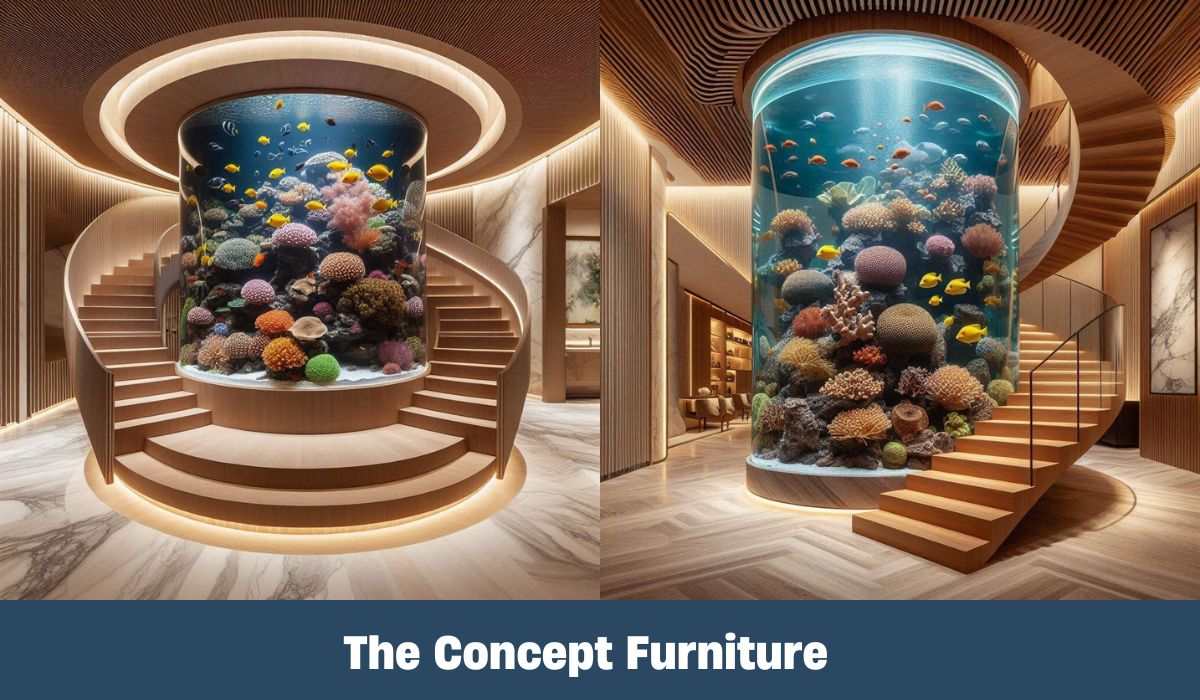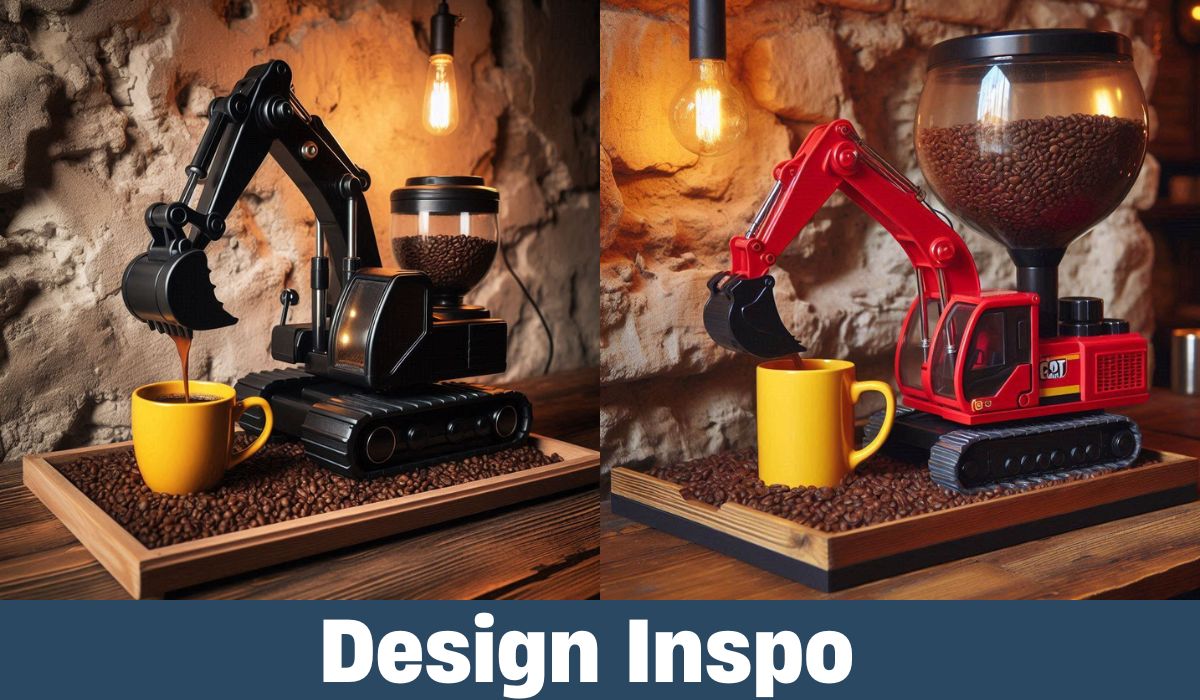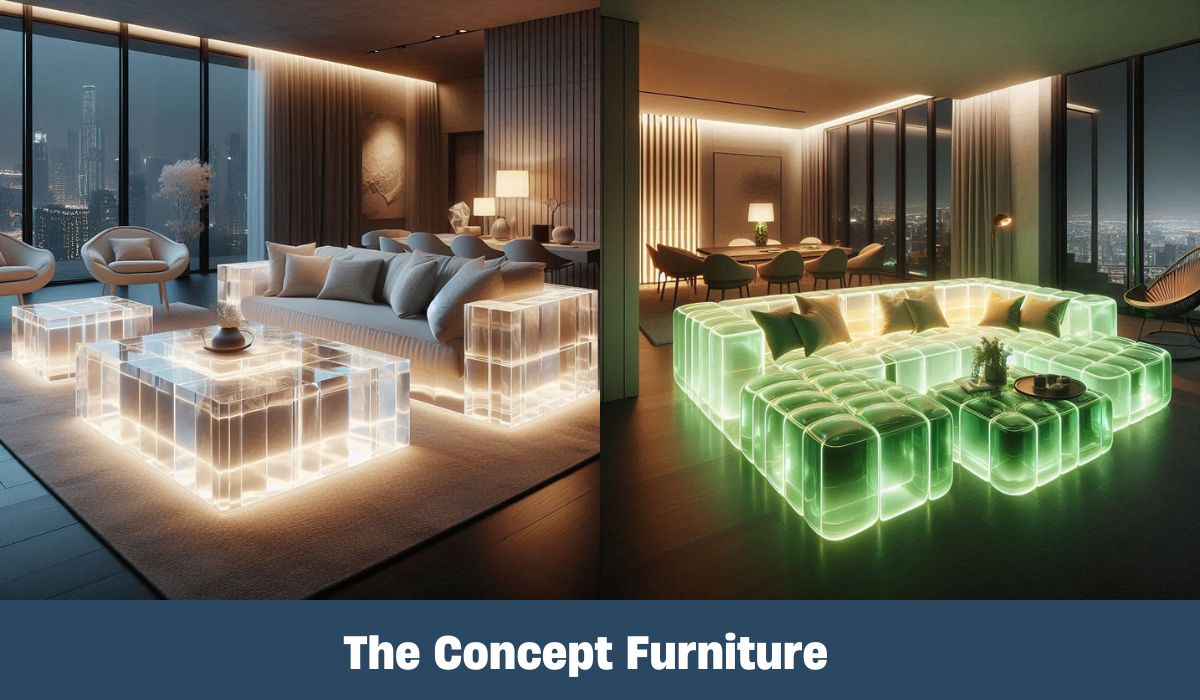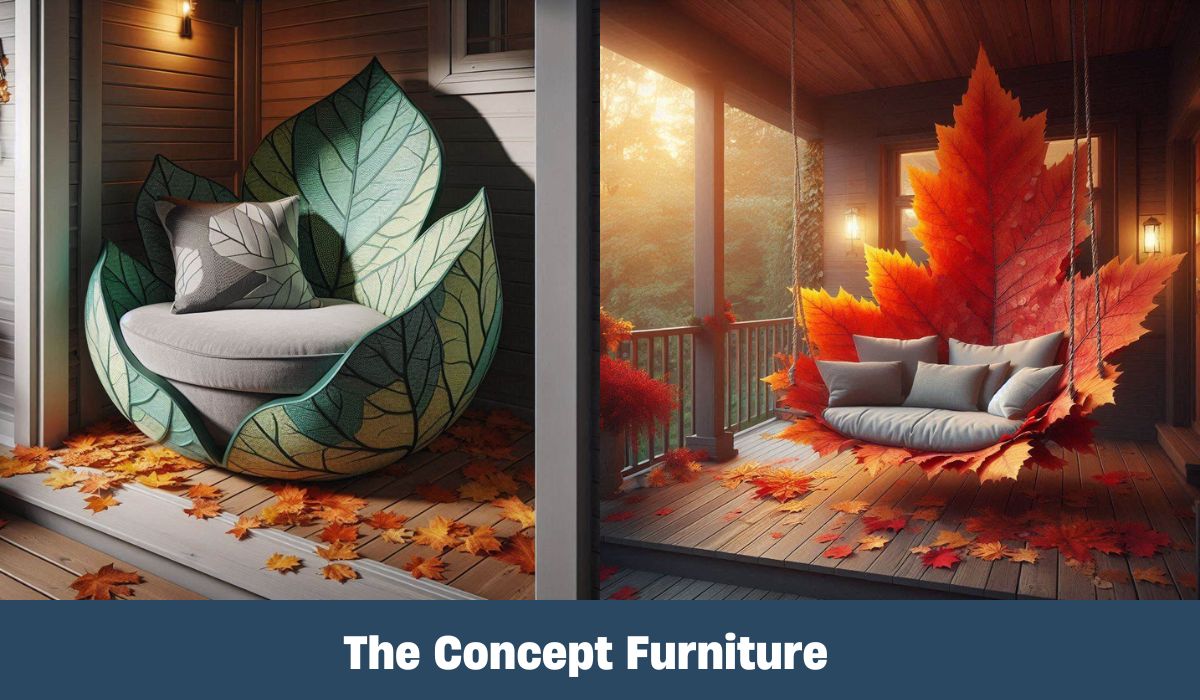The concept of spiral staircase aquariums showcases a remarkable interplay between architecture, design, and the tranquility of aquatic life. They are not merely functional structures; they embody artistry that captivates the imagination and brings nature indoors.
Introduction to Spiral Staircase Aquariums
Creating an ambiance that seamlessly merges beauty with functionality is an ongoing pursuit for many homeowners and designers. Spiral staircase aquariums offer an innovative solution to enhance both aesthetics and practicality in spaces where every square foot counts. These unique installations serve as eye-catching focal points while also providing a habitat for aquatic life.
A spiral staircase aquarium combines the elegance of a traditional spiral staircase with the captivating allure of aquatic environments. The harmonious blend of these two elements not only elevates the visual appeal of a space but also introduces a serene atmosphere that promotes relaxation and contemplation. As urban living becomes more condensed, such designs provide a viable option for integrating nature within confined spaces.
Concept and Design Inspiration
The inspiration for spiral staircase aquariums often stems from nature itself, particularly the natural shapes found in shells, vines, and other organic forms. Designers leverage these inspirations to create structures that mimic these curvilinear forms while serving practical functions.
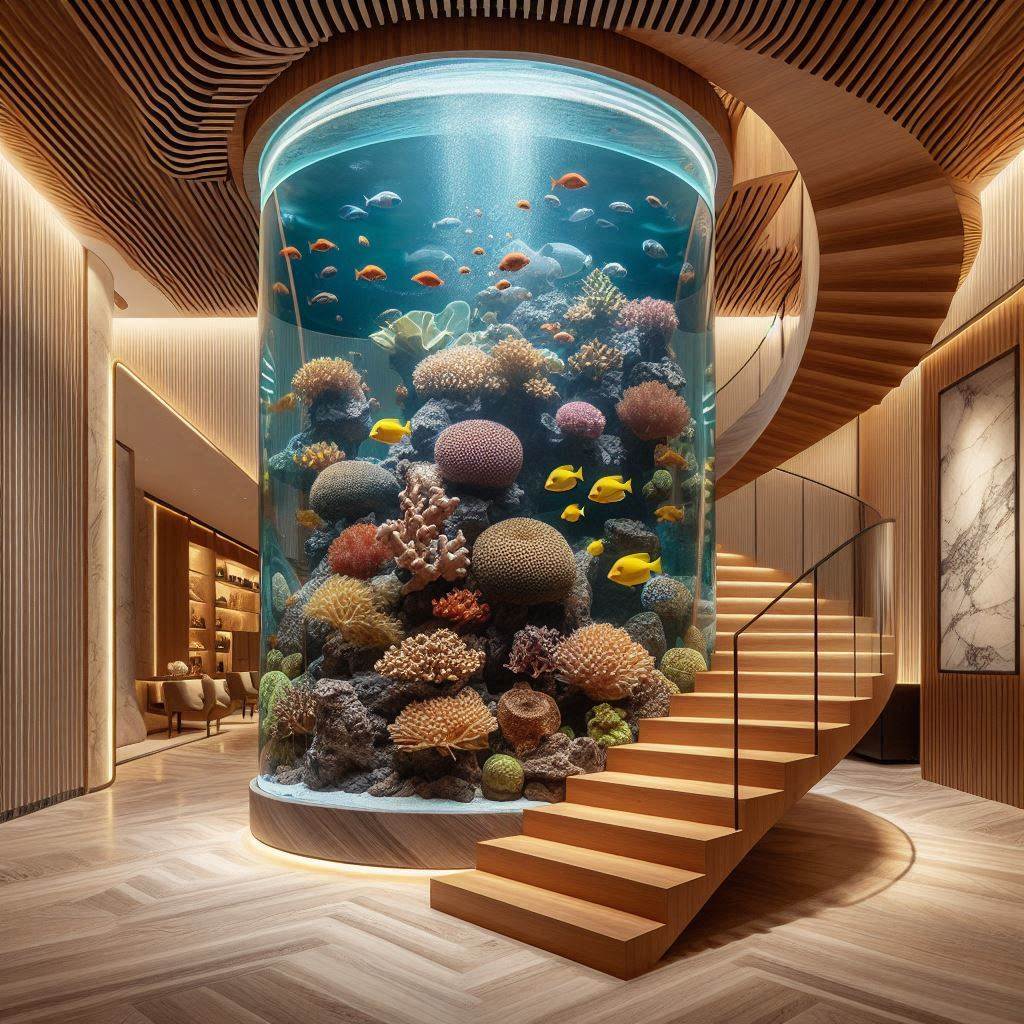
The essence of a spiral evokes thoughts of movement, transformation, and growth, which resonates profoundly with aquatic ecosystems. Integrating aquariums into staircases allows for a dynamic display that changes with light and motion throughout the day. This fusion of art and nature reflects a modern approach to design, where the goal is not just to fill space but to create immersive experiences that engage the senses.
Benefits of Combining Aquariums and Staircases
Incorporating spiral staircase aquariums into interior spaces provides numerous benefits. From maximizing limited floor space to enhancing air quality through the introduction of plants and water features, these installations transform the ordinary into extraordinary.
Additionally, the calming presence of fish swimming through lush aquatic landscapes contributes positively to mental well-being. Many studies highlight the therapeutic effects of watching aquariums, helping reduce stress and anxiety. Thus, these installations can be seen not only as aesthetic enhancements but also as havens for psychological refuge amid busy lives.
The Aesthetics of Spiral Staircase Aquariums
The aesthetic value of spiral staircase aquariums cannot be overstated. They serve as bold statements in any space, commanding attention while blending seamlessly with various decor styles. Their visual impact is grounded in the architectural components and how they integrate with existing interiors.
Architectural Appeal
The unique shape of spiral staircase aquariums offers architects and designers an opportunity to push boundaries and explore creative designs. These structures can be tailored to fit various architectural styles—from modern and minimalist to more traditional themes—allowing them to adapt to diverse environments.
With their sweeping curves and dynamic presence, spiral staircase aquariums can draw the eye upward, creating an illusion of height in smaller spaces. This architectural sophistication invites onlookers to appreciate the intricacies of design while simultaneously engaging with the natural beauty of the aquatic life within.
Interior Design Integration
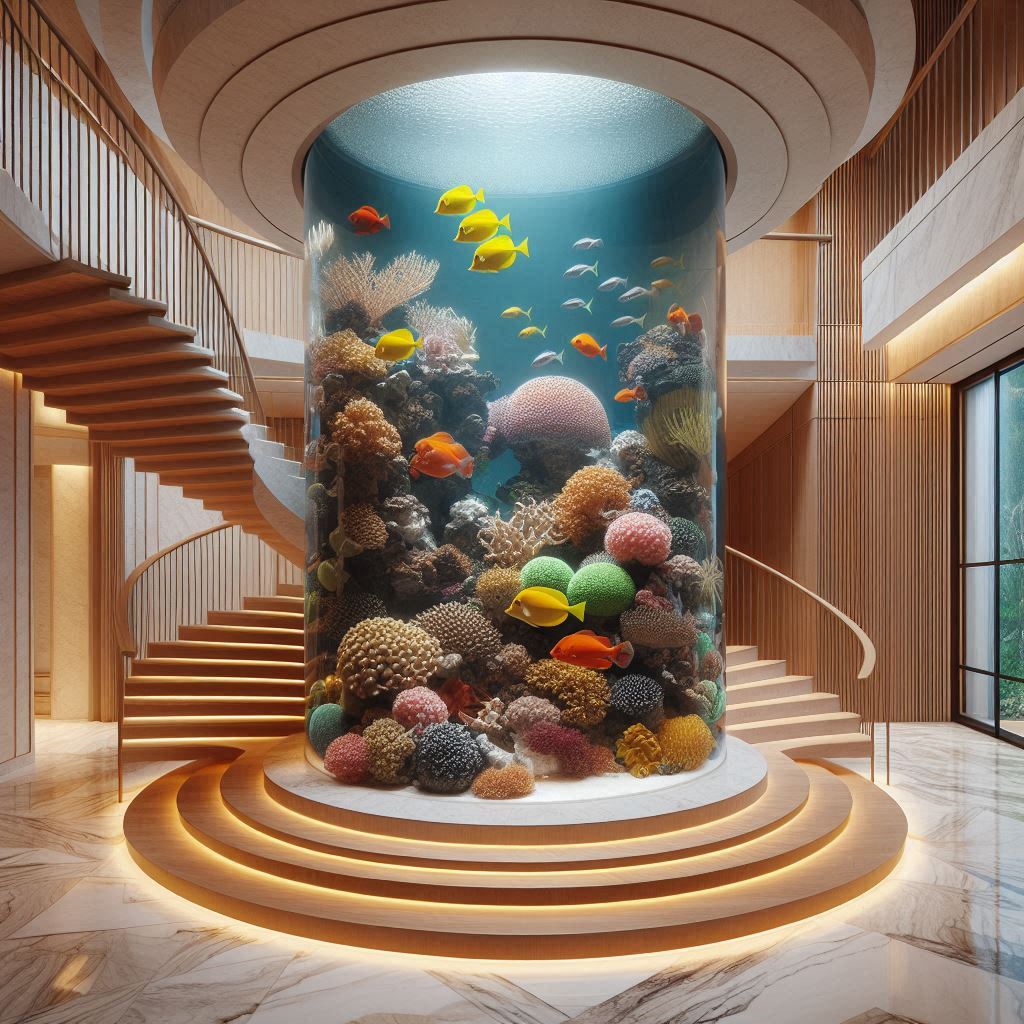
Beyond mere function, spiral staircase aquariums become integral parts of interior design schemes. They allow for creativity in color, texture, and form, contributing to the overall ambiance of a room. Depending on the materials used and the accompanying decor, these installations can evoke feelings of tranquility or vibrancy, depending on one’s design intentions.
Moreover, with careful consideration of lighting and placement, these aquariums can enhance existing furnishings and architectural elements. Whether serving as a centerpiece in a grand foyer or a subtle accent in a cozy reading nook, the integration of aquariums into interior spaces breathes new life into stagnant designs.
Customization Options for Personal Style
One of the most exciting aspects of spiral staircase aquariums is the vast array of customization options available. Homeowners can tailor their installations to reflect personal style and preferences, ensuring no two spiral staircases are alike.
From selecting specific fish species to choosing decorative elements like pebbles, corals, and aquatic plants, each installation tells a unique story. Furthermore, custom lighting options can create an ever-changing environment, inviting users to experience their aquarium in a multitude of ways at different times of the day.
Types of Spiral Staircase Aquariums
Exploring the types of spiral staircase aquariums available can help potential owners envision the possibilities. These installations come in various forms, each catering to different needs, environmental conditions, and aesthetic tastes.
Indoor Spiral Staircase Aquariums
Indoor spiral staircase aquariums are perhaps the most popular choice for homeowners. These installations serve dual purposes: facilitating movement between floors while providing a stunning visual display of aquatic life.
When designing indoor aquariums, factors such as room size, light availability, and temperature control play crucial roles. Well-designed indoor aquariums can contribute to improved air quality by introducing humidity and supporting plant life, ultimately enhancing the indoor environment. The inclusion of aquatic plants not only adds beauty but also plays vital roles in filtration and oxygenation within the aquarium ecosystem.
Outdoor Spiral Staircase Aquariums

Outdoor spiral staircase aquariums represent another exciting avenue for design innovation. Perfect for gardens, patios, or outdoor entertainment areas, these aquariums bring the beauty of aquatic life into open-air spaces.
Constructing outdoor aquariums requires careful planning to accommodate weather-related challenges such as fluctuating temperatures and exposure to the elements. Thoughtful design choices like sun protection and temperature regulation ensure that aquatic inhabitants thrive year-round.
Their presence outdoors transforms gardens and patios into exotic retreats, drawing visitors to marvel at the artistry and serenity these installations provide.
Floating Spiral Staircase Aquariums
An increasingly popular trend in aquarium design involves creating floating spiral staircase aquariums. These breathtaking installations appear to defy gravity, resting elegantly above the ground while still serving as functional staircases.
Floating designs inspire awe and challenge conventional notions of structure and stability, showcasing engineering prowess alongside artistic vision. While visually striking, achieving the necessary structural integrity for a floating aquarium requires advanced engineering techniques.
Such installations can serve as conversation starters and focal points in contemporary homes, illustrating the seamless combination of art and science in design.
Materials Used in Spiral Staircase Aquariums
The materials chosen for spiral staircase aquariums significantly influence their durability, aesthetics, and maintenance. Knowing what materials are best suited for these unique structures can aid prospective builders in making informed decisions.
Glass Types and Their Properties
Glass serves as the primary material for constructing the tanks themselves, offering clarity and visibility for observing aquatic life. Different glass types may possess distinct properties—such as thickness and resistance to pressure—affecting their suitability for particular designs.
Tempered glass, known for its strength and safety, is a common choice for aquariums. It can withstand significant pressure, making it ideal for larger installations. Additionally, acrylic alternatives provide lighter weight and greater flexibility in shaping designs, though they may require more frequent polishing to maintain clarity.
Frame Materials: Wood, Metal, and More
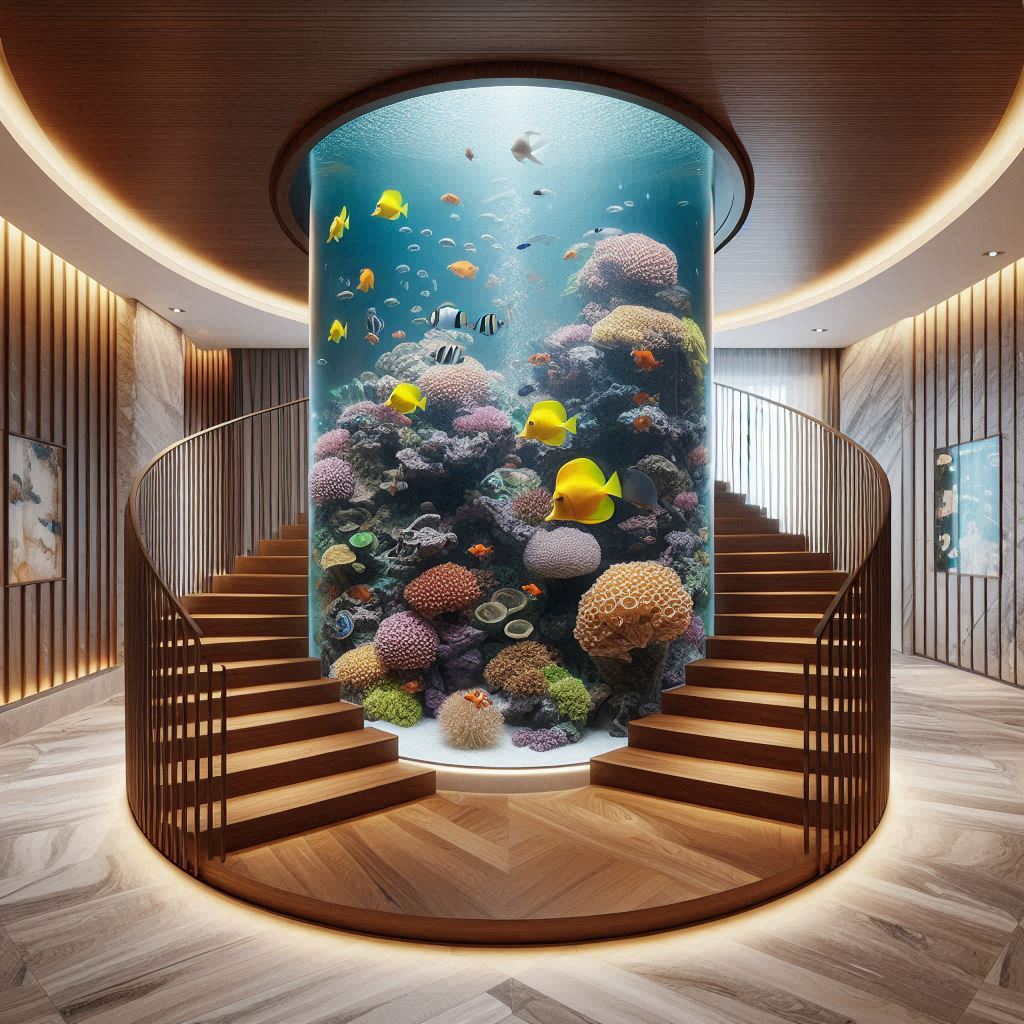
The frames of spiral staircase aquariums can be constructed from various materials, including wood, metal, or even composite materials. Each choice carries its own aesthetic implications and structural capabilities.
Wooden frames lend warmth and organic charm to installations, harmonizing with natural settings. However, care must be taken to prevent moisture damage over time. On the other hand, metal frames enamor those drawn to industrial aesthetics, offering sturdiness and resilience against wear and tear.
Regardless of choice, ensuring that frame materials are treated for water resistance is fundamental in maintaining structural longevity.
Sealants and Water Conditioning Solutions
To maintain a healthy aquatic environment, selecting reliable sealants is vital to prevent leaks and keep water levels stable. High-quality silicone sealants specifically designed for aquariums are essential to maintaining the integrity of the tank.
In addition to sealing, using appropriate water conditioning solutions ensures a balanced and safe environment for aquatic life. Regular testing and monitoring of water parameters, such as pH, ammonia, and nitrate levels, will support thriving ecosystems and lead to healthier aquatic inhabitants.
Building a Spiral Staircase Aquarium
Building your own spiral staircase aquarium can be a rewarding endeavor that combines creativity, craftsmanship, and a passion for marine life. However, careful planning and execution are crucial to ensure safety and functionality throughout the process.
Planning and Measurement Considerations
Before embarking on construction, careful planning is mandatory. Understanding the desired dimensions, location, and functionality of the aquarium will provide a clearer roadmap for your project.
Accurate measurement is paramount, especially when determining the overall height and weight distribution of the structure. Assessing the available space ensures that the aquarium will complement rather than overwhelm the surrounding area.
Additionally, considering access for maintenance and cleaning is vital for long-term sustainability.
Structural Integrity and Safety Features
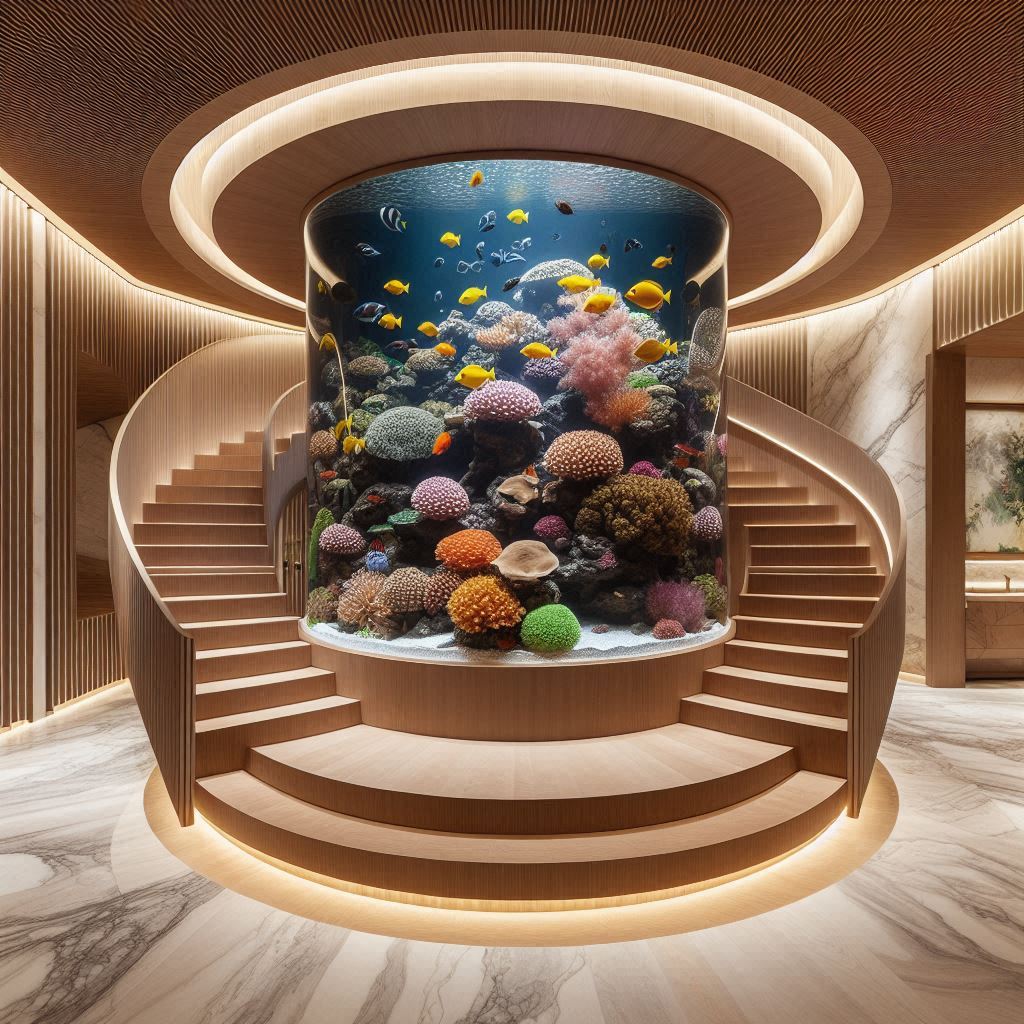
Given the unique design of spiral staircase aquariums, prioritizing structural integrity is non-negotiable. Collaborating with engineers or architects familiar with aquarium designs can ensure that all safety measures have been considered.
Including safety features such as railings and slip-resistant surfaces will further enhance usability, especially in homes with children or pets. Regular inspections of structural components will help address any issues before they escalate into serious problems.
Step-by-Step Construction Process
The construction process typically involves several phases, starting with laying the foundation and securing the frame for the staircase. Once the framework is established, the tank can be assembled using pre-cut glass or acrylic pieces, ensuring that seals are watertight.
Next, install the appropriate filtration systems and plumbing to maintain a healthy aquatic environment. By following best practices in waterproofing and ensuring proper drain mechanisms, you can enhance the long-term reliability of your installation.
Finally, populate your aquarium with carefully selected aquatic life, taking time to cycle the tank properly before adding fish and plants. Ultimately, patience during the building process will reward you with a stunning focal point for your home.
Maintenance of Spiral Staircase Aquariums
Owning a spiral staircase aquarium comes with responsibilities, primarily centered around maintenance. Keeping the ecosystem thriving and beautiful requires regular attention and dedication.
Regular Cleaning Protocols
Establishing a routine cleaning schedule is critical to maintaining water quality and the overall health of inhabitants. This includes cleaning the glass surfaces, removing algae buildup, and replacing filters as necessary.
Using specialized aquarium-safe cleaners will protect the environment while ensuring that visual clarity remains uncompromised.
Additionally, vacuuming substrate and performing partial water changes are essential practices to prevent the accumulation of waste and pollutants within the aquarium.
Water Quality Management
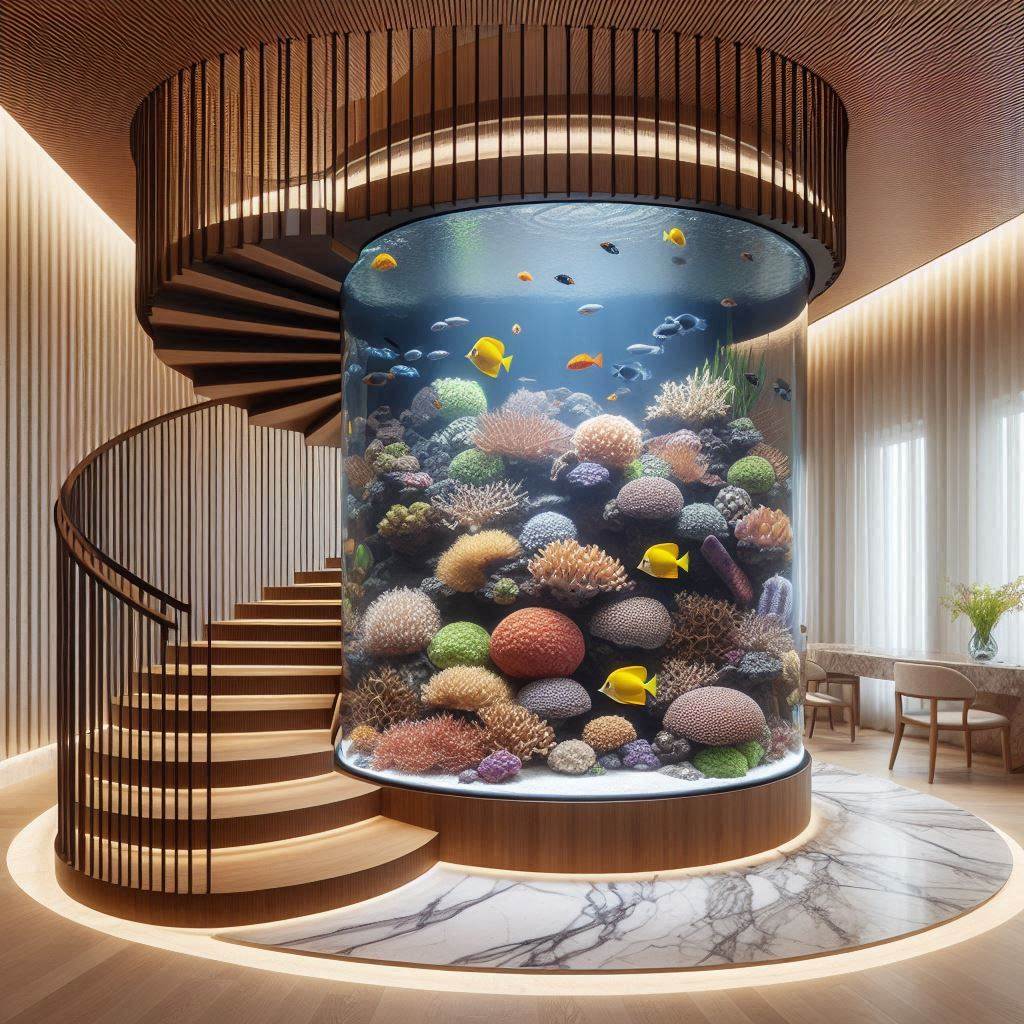
Monitoring and managing water quality is imperative in creating a balanced ecosystem. Regular testing for parameters such as pH, hardness, ammonia, nitrite, and nitrate levels helps identify potential issues early.
Keeping a consistent water temperature, aided by heaters and chillers if needed, is equally important to provide a stable environment for aquatic life. Employing water conditioners can assist in maintaining a balanced chemical environment, promoting thriving ecosystems.
Fish and Plant Care
Taking care of the living organisms within your spiral staircase aquarium will require dedicated attention to their needs. Understanding the species’ compatibility, dietary requirements, and behavioral traits fosters a nurturing environment.
Regularly inspecting plants for signs of disease or decay and promptly addressing algae growth will keep the ecosystem functioning optimally. Additionally, providing adequate lighting and nutrient supplements for plants enhances their growth, contributing to an enriched aquatic landscape.
Selecting the Right Fish and Plants
Choosing the right fish and plants for your spiral staircase aquarium is a journey that blends aesthetic desires with ecological considerations. The species selected should not only complement the visuals but also thrive within the created environment.
Compatible Species for Your Aquarium
Researching compatible fish species is key in developing a harmonious aquarium. When selecting fish, consider their adult sizes, temperaments, and environmental needs.
Community tanks work best with peaceful fish that can coexist, while territorial species may require a more isolated setup.
Pairing fish with varying colors, shapes, and sizes can create a vibrant tapestry of aquatic life that entices viewers, but always prioritize compatibility to prevent aggression.
Aquatic Plants That Thrive in Spiral Settings

Plants play an integral role in maintaining water quality and providing shelter for fish. Choosing suitable aquatic plants can enhance the beauty of your spiral staircase aquarium while aiding in filtration and oxygenation.
Options such as Anubias, Java Fern, and Cryptocoryne are popular choices for low light and easy-care varieties. Incorporating floating plants can also add depth and texture, creating a relaxing oasis for both fish and humans.
Creating a Balanced Ecosystem
Achieving balance within your aquarium ecosystem involves understanding the interdependence between fish, plants, and water parameters. Establishing a proper ratio of fish to plants and ensuring adequate filtration and aeration promotes harmony.
Regular observations will help identify imbalances, allowing quick intervention before issues arise. By fostering a thriving ecosystem, both fish and plants can flourish, resulting in captivating displays that enthrall viewers.
Lighting Considerations for Spiral Staircase Aquariums
Lighting plays a pivotal role in the success and appearance of spiral staircase aquariums. From highlighting the beauty of aquatic life to promoting plant health, thoughtful lighting design is essential.
Types of Lighting Fixtures
Aquarium lighting options vary widely, from traditional fluorescent fixtures to modern LED solutions. Selecting the right type depends on the specific needs of both fish and plants.
LED lights have gained popularity due to their energy efficiency, versatility, and longer lifespan compared to outdated fluorescent bulbs. Moreover, adjustable spectrum settings allow users to simulate natural daylight, enhancing plant growth while creating visually appealing aquatic habitats.
Lighting Placement and Aesthetic Effects
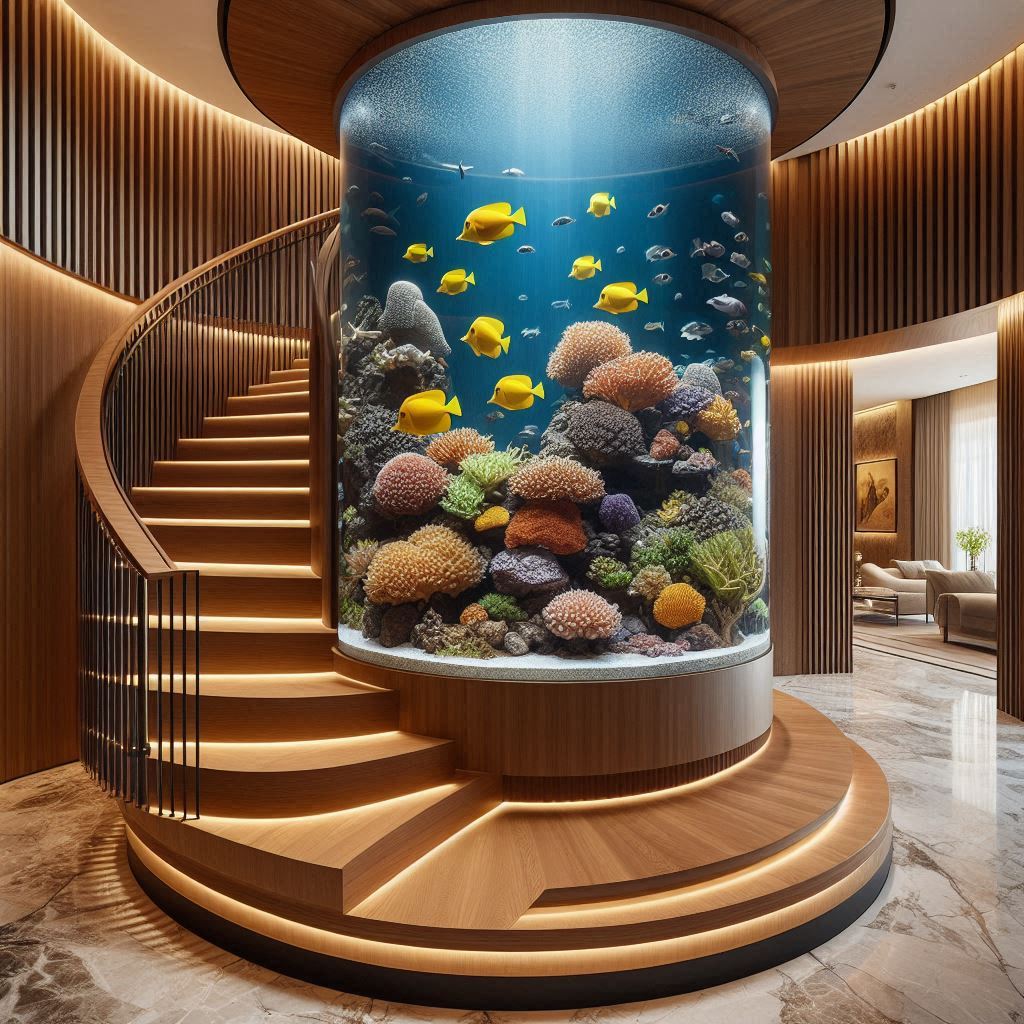
Proper placement of lighting fixtures can foster dramatic effects within the aquarium. Strategically positioning lights above the tank, angled to minimize glare and maximize coverage, creates an immersive environment.
Utilizing spotlights or moonlighting features can enhance nighttime viewing experiences, allowing observers to appreciate the intricate details of the underwater world.
Furthermore, experimenting with colored filters can produce enchanting moods, giving you the ability to transform the atmosphere according to personal preference.
Impact on Aquatic Life
The impact of light on aquatic life extends beyond aesthetics; it influences behavior, growth, and overall well-being. Different species require varying light intensities, so understanding the needs of your chosen fish and plants is crucial.
Too much light may promote unwanted algae growth, while insufficient light can hinder plant photosynthesis. Striking an equilibrium ensures that aquatic inhabitants thrive while maintaining the tank’s visual allure.
Cost Analysis of Spiral Staircase Aquariums
While the allure of spiral staircase aquariums is undeniable, prospective owners must weigh costs against benefits. Understanding the financial implications of installation and upkeep is essential for informed decision-making.
Initial Setup Costs
The initial setup costs associated with constructing a spiral staircase aquarium can vary widely based on size, materials, and complexity. Customizations, such as premium materials or intricate designs, can elevate expenses significantly.
Investing in quality equipment—such as filtration systems, lighting, and heating—will incur upfront costs but pays dividends in the long term through effective maintenance.
In addition to physical materials, hiring professional help for installation may increase overall costs but ensures a structurally sound setup.
Long-Term Maintenance Expenses
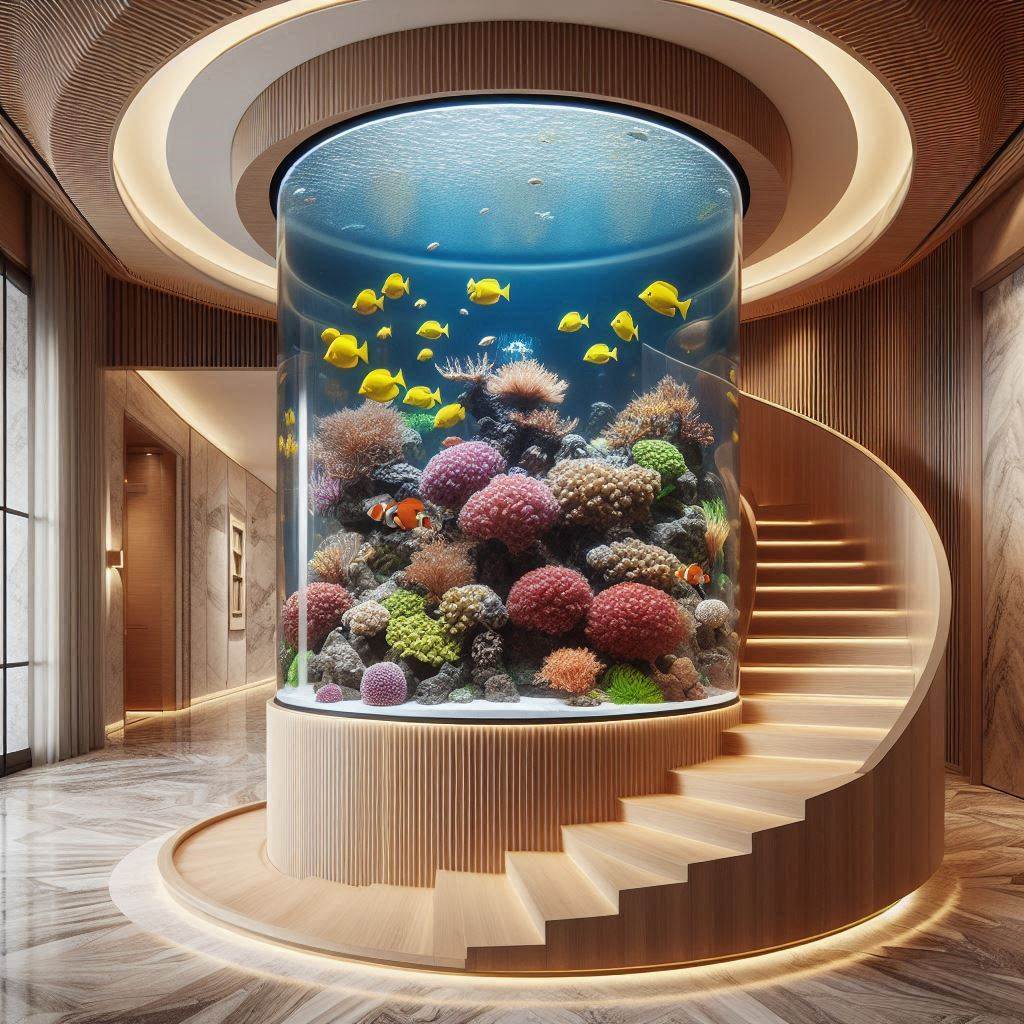
Owning a spiral staircase aquarium entails ongoing maintenance expenses that warrant consideration. Regular purchases of water conditioners, food, and replacement filters contribute to monthly and yearly budgets.
Utility costs, particularly those related to electricity consumption for lighting and filtration, can also accumulate over time.
However, many enthusiasts find joy in caring for their aquariums, viewing these costs as investments in a living art piece that enriches the home environment.
Value Addition to Property
The artistic and functional qualities of spiral staircase aquariums can add significant value to a property. As unique installations that bridge the gap between nature and architecture, they entice buyers looking for distinctive features.
Incorporating such installations can enhance curb appeal, making your home more attractive in a competitive real estate market. Therefore, while initial and ongoing costs may seem daunting, the potential for increased property value can offset expenses over time.
Innovative Uses of Spiral Staircase Aquariums
As the concept of spiral staircase aquariums continues to evolve, innovative uses for these installations emerge across various sectors. Exploring these applications reveals the broad potential and versatility of this unique design.
Commercial Applications in Businesses
Businesses seeking to make a memorable impression can benefit from spiral staircase aquariums in commercial spaces. Restaurants, hotels, and spas have begun incorporating aquariums as focal points within their designs, elevating customer engagement through captivating aesthetics.
These installations create tranquil atmospheres that invite relaxation and enjoyment, encouraging patrons to linger longer and return frequently.
Additionally, incorporating aquariums into office spaces promotes employee wellness, reducing stress, and improving productivity through their calming presence.
Educational Opportunities in Schools
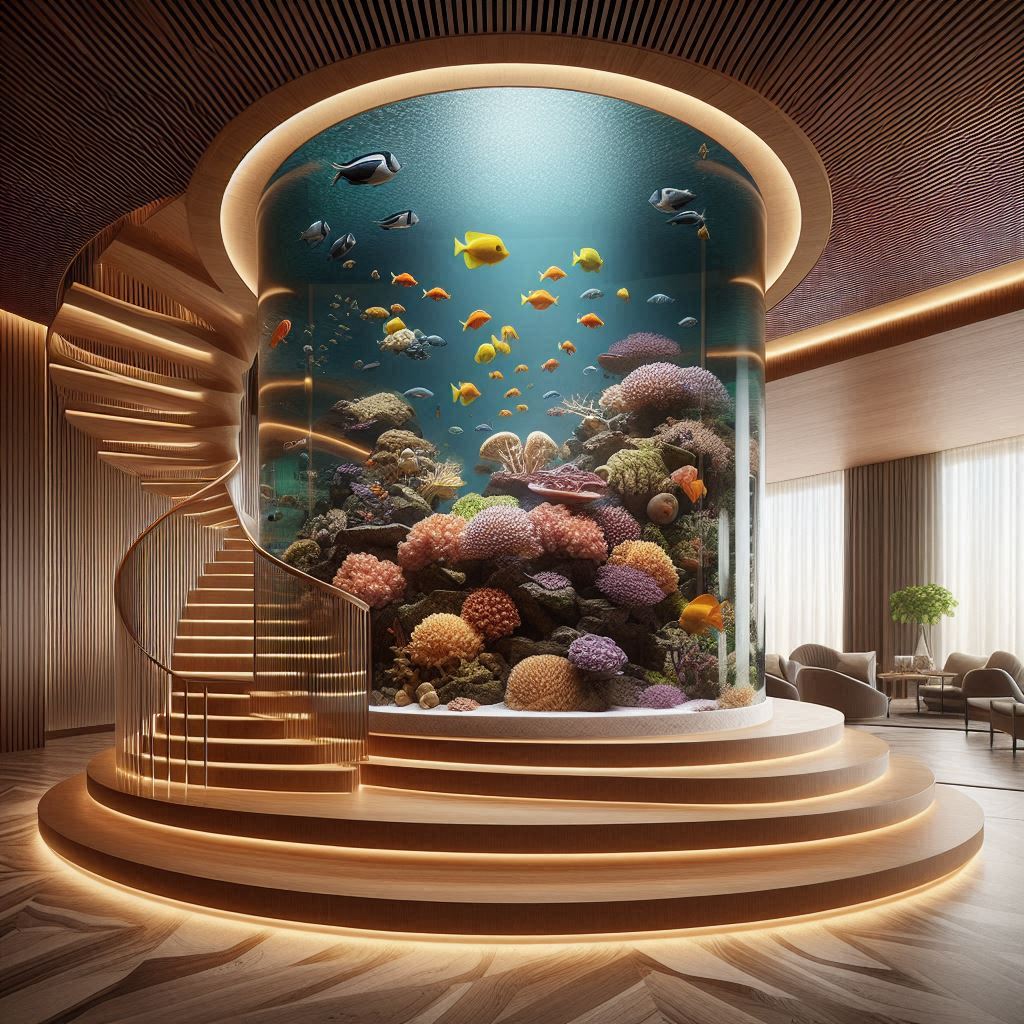
In educational settings, spiral staircase aquariums can foster curiosity and learning about aquatic ecosystems. Schools embracing innovative educational methods can utilize these installations as dynamic teaching tools, igniting interest in marine biology, ecology, and conservation.
Interactive elements, such as live feeding demonstrations or responsibility-sharing among students, can empower engagement and foster stewardship for aquatic environments.
Such programs not only enrich classroom experiences but also instill an appreciation for biodiversity and environmental preservation in young minds.
Therapeutic Spaces for Wellness
The therapeutic benefits of aquariums are being harnessed in wellness centers and healthcare facilities. The calming effects of observing aquatic life contribute to stress reduction, allowing patients to find solace and comfort during their treatment journeys.
Implementing spiral staircase aquariums within therapeutic spaces can create serene environments conducive to healing and relaxation. Such initiatives reflect a holistic approach to health, where physical, emotional, and mental well-being intertwine.
Case Studies of Spiral Staircase Aquariums
Highlighting notable examples of spiral staircase aquariums can provide valuable insights into successful implementations. Exploring case studies allows aspiring owners to glean inspiration and learn from others’ experiences, both positive and negative.
Notable Installations Around the World
Across the globe, several stunning examples of spiral staircase aquariums capture the imagination. Iconic installations in luxury hotels, residential homes, and public spaces showcase the endless possibilities inherent in this design.
Famous installations demonstrate how these projects can transcend mere decoration to become central features that define spaces, alluring visitors and residents alike.
Examining these examples highlights diversity in design, emphasizing the translation of concepts into tangible, awe-inspiring realities.
Success Stories from Homeowners
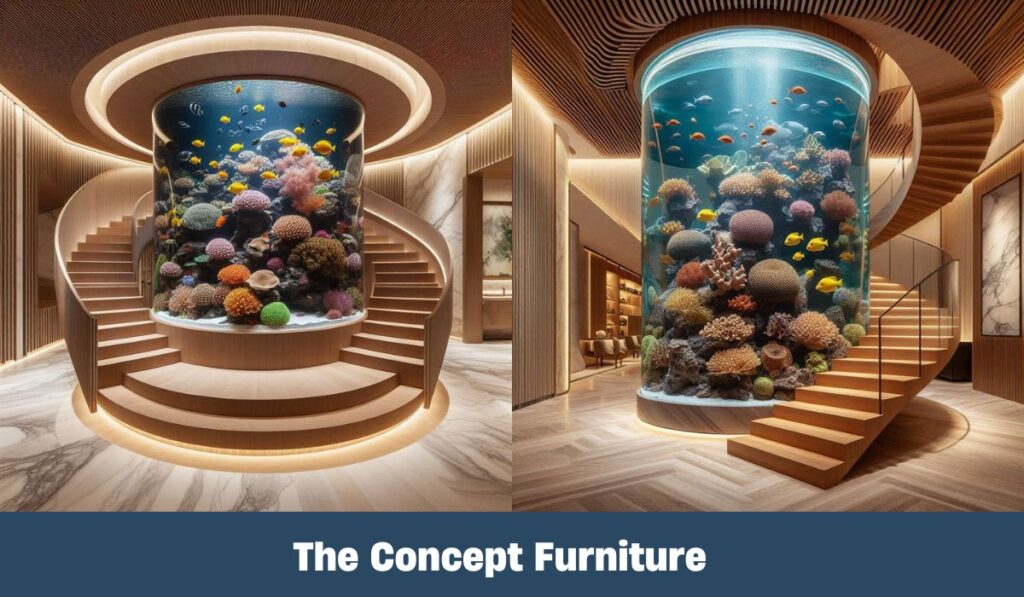
Homeowners who embrace spiral staircase aquariums often share stories of transformative experiences within their spaces. From hosting social gatherings centered around the aquarium to cultivating a personal sanctuary, these installations reshape perspectives on what home can entail.
Success stories often emphasize the emotional and psychological benefits derived from having living art within reach. Enthusiasts express pride in their unique acquisitions, knowing they play an active role in nurturing aquatic life and contributing to the broader ecosystem.
Challenges Faced and Overcome
Despite the beauty and allure of spiral staircase aquariums, challenges inevitably arise. Accounts from homeowners reveal difficulties ranging from maintenance hurdles to managing water quality and fish compatibility.
The lessons learned from these challenges yield invaluable insights for future owners. Strategies for overcoming obstacles—be it employing technology solutions, enlisting professional help, or adopting best practices—demonstrate resilience and adaptability within the aquarium-owning community.
Environmental Impact Considerations
As the popularity of spiral staircase aquariums rises, it is essential to address their environmental impact. This consideration ensures that these installations contribute positively to both local ecosystems and global efforts toward sustainability.
Sustainable Practices in Aquarium Setup
Adopting eco-friendly practices during the construction and operation of aquariums is paramount in minimizing environmental footprints. Utilizing reclaimed materials, such as recycled glass or repurposed wood, can reduce resource demands while adding character to installations.
Moreover, embracing sustainable filtration systems and energy-efficient lighting options decreases energy consumption and promotes responsible aquarium ownership.
Practices such as sourcing fish and plants from sustainable suppliers further align with ecological responsibilities, reducing harm to natural habitats.
Eco-Friendly Material Choices
Choosing eco-friendly materials goes hand in hand with sustainable practices in aquarium setups. Opting for biodegradable sealants, sustainably sourced woods, and recyclable metals fosters a commitment to environmental stewardship without compromising quality or aesthetics.
Integrating living plants into the aquatic environment can also improve air quality and contribute positively to local ecosystems, benefiting both inhabitants and homeowners.
Conservation Efforts Supported by Aquariums
Many aquarium owners choose to support conservation efforts through their installations. By raising awareness about dwindling aquatic habitats and promoting responsible fishing practices, these installations serve as platforms for education and advocacy.
Participation in community-based conservation initiatives underscores the role of aquariums in protecting vulnerable ecosystems, fostering a sense of shared responsibility toward preserving biodiversity.
Conclusion
As we have explored throughout this article, spiral staircase aquariums present a unique intersection of art, design, and nature. They serve as captivating focal points that enrich living spaces while promoting tranquility and connection to the natural world.
Whether utilized in homes, commercial establishments, or educational institutions, the potential benefits extend far beyond aesthetics alone. With careful planning, conscious material choices, and ongoing maintenance, these installations can thrive, creating harmonious ecosystems that contribute positively to the environment.
As technology advances and our understanding of aquatic ecosystems deepens, the future holds promising possibilities for innovative designs and sustainable practices in aquarium setups. Embracing these opportunities will allow us to cultivate environments that celebrate nature while enriching our lives through beauty, engagement, and harmony.

